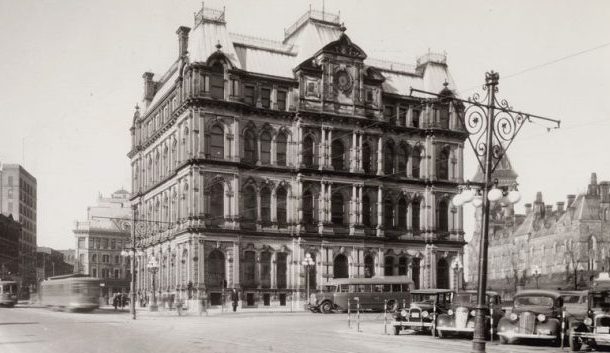It was one of Ottawa’s greatest architectural losses, the original Customs House. It stood 62 years and even launched the career of a national leader, Mackenzie Bowell, whose primary achievement was growing the finest beard of any prime minister.
Customs revenue ran the country in the Confederation era. Taxes collected on liquor and goods were the main source of cash for the colony til the introduction of federal income tax in 1917.
The Customs building was constructed in the iconic heart of Ottawa at Elgin and Wellington Streets overlooking the Rideau Canal. It rose four storeys with a clock tower, designed in the grand Empire style by architect Walter Chesterton. The landmark took three years to build and opened in 1877.
Running the Customs House as the nation’s chief tax collector was Mackenzie Bowell, an editor and Orange Lodge Grandmaster from Belleville, Ont. He served 50 years in Ottawa without ever having to commute. Bowell kept a room at the fabulous Russell Hotel, simply walked across the street to the Customs building and another block up to the House of Commons.
Bowell was a master of patronage, stacking the Customs department with Conservative cronies. He made it a rule to fire any employee who attended Liberal meetings. In 1880 he wrote John A. Macdonald: “Everything in the whole system of government in connection with patronage is carried out on this principle: You consult your friends.”
Bowell operated the Customs house with unremarkable diligence. In 1894 he became prime minister on seniority following the sudden death of Conservative leader John Thompson.
Bowell spent 16 unhappy months in office. Today he is universally rated the country’s worst prime minister. He was “decidedly commonplace,” said Lady Aberdeen, a governor general’s wife. One historian remembered Bowell as a “bigoted, conceited and slightly paranoiac little man.”
Bowell was ousted in a cabinet revolt in 1896. A caucus colleague rated him “pompous and ponderous.” Seven cabinet members resigned after branding Bowell a dithering fool. The Ottawa Evening Journal called him “a leader who cannot lead.” He died in such obscurity in 1917 that Prime Minister Robert Borden did not attend the funeral.
And the old Customs House? It survived a fire in 1903, was restored with walls of nearly indestructible concrete, and lasted till 1938 when it was deemed to be in the way of plans for a National War Memorial. Bowell’s office was so well-built it took two months to dismantle the reinforced walls.
“The old building always held a warm place in the hearts of Ottawans,” a newspaperman wrote as the Customs House was demolished. “Even today citizens are noted looking up to where the well-known clock used to be in order to check their timepieces.”
By Andrew Elliott









